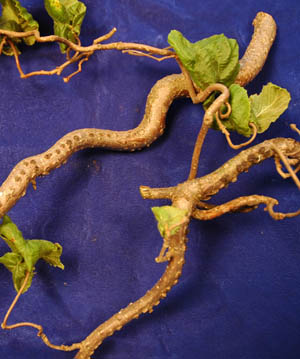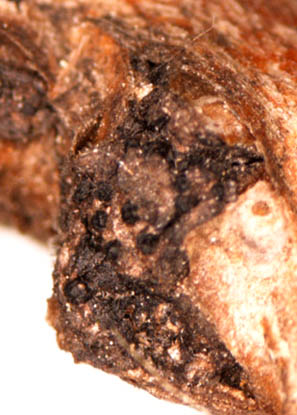Eastern Filbert Blight | |
|---|---|
| July 1, 2008 | |
|
We have seen two cases of eastern filbert blight in the past week at the Plant Clinic. In addition, we received a phone inquiry about this problem. Undoubtedly, others in Illinois are seeing this disease as well. The host is Corylus (filbert, hazelnut). The two clinic cases were on Harry Lauder’s Walking Stick, Corylus avellana ‘Contorta’. For more on this species, visit http://woodyplants.nres.uiuc.edu/plant/coravco. Symptoms of filbert blight include dead stems, dieback, and tiny football-shaped cankers with rows of black fruiting bodies within the cankers. This first image shows two stems with few leaves and many of these diagnostic fruiting bodies. This disease can be very damaging to susceptible plants. If infected wood is not removed, the canker continues to enlarge and move into older wood, killing the plant in 3 or more years. When removing infected wood, be sure to cut well into healthy wood. If small cankers remain, they enlarge and continue the disease process. European filbert (Corylus avellana) cultivars are particularly susceptible to infection. The fruiting bodies (perithecia) form in the infected wood a year or two after initial infection. By the time we see this sign of disease, the tree has already been infected for 1 to 2 years. For this reason, even judicial pruning may not effectively stop the disease. In some parts of the country, annual pruning and fungicide sprays are used to control this disease. Infection occurs in the spring on new leaves and succulent shoot tips. If fungicides are used, this tissue should be targeted to prevent infection. We do not know of a fungicide registered specifically for this pathogen on ornamental filberts. Some fungicides have general-use labels, such as thiophanate-methyl sold as Fertilome Halt or Scotts Lawn Fungicide Control for homeowners. There are many broadly labeled products for commercial growers, including Cleary 3336, ConSyst, Fungo, OHP6672, Phyton 27, SysStar, SysTec, Tee-Off, Terraguard, Triact, and T-Storm. Always read the selected label carefully before applying a fungicide. | |
| Author: | Nancy Pataky |


